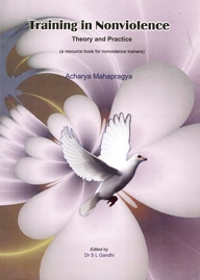The third part of nonviolence training is the development of nonviolent lifestyle. When a student begins to feel inclined towards a culture of ahimsa after his exposition to its theory and practice, he is supposed to adopt a nonviolent lifestyle embedded in self-restraint for the rest of his life. The essential ingredients of nonviolent lifestyle are as follows:
- Abstinence from unnecessary violence
- Abstinence from killing innocent human beings
- Abstinence from committing aggression
- Abstinence from participation in violent agitations and destructive activities
- Faith in human solidarity
- Religious tolerance
- Practising rectitude and honesty in day-today dealings
- Setting limits to acquisition and practising self-restraint
- Adoption of pure and ethical means in elections
- Abstinence from encouraging socially evil customs
- Abstinence from intoxicants and drugs
- Refraining from causing environmental pollution
- Development of ecologic ethic
The individual who chooses nonviolent lifestyle is expected to practise the following in his daily life.
- Commitment to a global ethic (anuvrats - basic vows)
- Practice in eating less - reducing items of eating during training - preparing for fasting
- Dignity of work (shramdan)
(i) Do all your work yourself
(ii) Participate in a voluntary work projects at school or at a poor persons’ colony - Silence - take a vow of silence at least for two hours a day during training period and utilize the time in swadhyaya (study of sacred and formative literature)
- Share your excess clothes and food with the poor and take a vow to do one good turn every day
- Meditate for at lest one hour daily - kayotsarg - long breathing, anupreksa etc. for attitudinal changes and undertake health rejuvenating practices
- Walk at least 4 kilometers a day during trainin
 Acharya Mahaprajna
Acharya Mahaprajna

